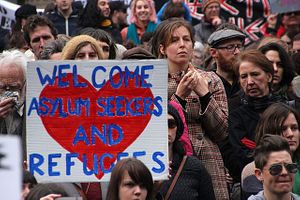When Opposition immigration spokesperson Richard Marles recently commented on Australia’s asylum seeker boat turn-back policy, the Australian media predictably stepped up to feed the nation’s obsession with boat arrivals. But what won’t be talked about on any newspaper front page in Australia, is the reluctance of both major parties to provide alternatives before refugees even think about getting on a boat.
In 2013, Asia and the Pacific was the region with the largest refugee population, at 3.5 million people. More than 51 million people are now displaced worldwide – the most since the second world war.
Speaking on the Syrian crisis last week – more than three million refugees have now fled the country – UN High Commissioner for Refugees António Guterres pointed to the “enormous” consequences for neighboring countries Lebanon, Jordan, Turkey, Iraq and Egypt. He called for nations around the world to step up assistance through development support for Syria’s neighbors and with “resettlement, humanitarian admission schemes, simplified family reunification or more flexible visa regulations” to aid refugees.
On the Abbott government’s deal for Cambodia to resettle refugees arriving to Australia, Guterres recently remarked that it was crucial “countries do not shift their refugee responsibilities elsewhere.” With 87 percent of the world’s refugees now hosted by developing countries, “international responsibility sharing” is needed more than ever, he said.
Australian immigration minister Scott Morrison recently claimed success in attracting a target of 190,000 new migrants to Australia in the latest financial year. But by contrast, the Abbott government has pushed boat refugees away from Australia and cut the formal refugee and humanitarian program from 20,000 (increased by Labor) back down to just 13,750.
Suggestions that asylum seekers applying through the “front door,” or the “right way,” will be rewarded with resettlement, are simply untrue for most refugees. As Paul Power from Australia’s Refugee Council noted recently, relatively few of the most desperate people ever apply to Australia for help – and when they do, very few succeed.
In the five years to June last year, more than 80 percent of applications for refugee resettlement to Australia were rejected. The rejection rate for Special Humanitarian visas was even higher at 92 percent. The rate went up to 97 percent for In-Country Special Humanitarian applicants, says Power.
And while Australia’s migration program has grown incrementally over the past decade, its humanitarian intake has not kept pace. In 2013/14, refugee and humanitarian entrants accounted for just 6.77 percent of Australia’s combined migration total. Only rarely over the past 30 years has the percentage been lower.
Expanding the refugee program back to 20,000 places would be an important immediate step – along with commitments to ensure those places are always filled – with a further rise to 30,000 over the next five years. But while resettlement remains intrinsic to the debates Australia should be having on refugee and asylum policy, focus must also turn to the needs of refugees waiting indefinitely in the wider region.
The Abbott Government’s deterrence policies are not designed to address the problems of refugees fleeing conflict and persecution. Their aim is simply to remove the “problem” from Australia and push it back on to other nations. But policies that force poorer countries to carry a greater load will inevitably have consequences for Australia.
Advocates within the region have long called for better protection, education opportunities, work rights, access to fair processes, the creation of real queues for those enduring long periods without resettlement – all measures that would stabilize refugee populations and discourage further dangerous trips, including by boat.
But, as Power says, Australia’s potential to influence policies in the region “is weaker now than it has ever been,” and its credibility diminished by perceptions of self-interest. Australia is seen increasingly as “a very wealthy and spoilt nation which wants to share in the benefits of global trade but much prefers to push responsibility for humanitarian crises back on its much poorer neighbors,” he says.
The Refugee Council believes incremental improvement throughout the region is now the only way forward. That by “gradually improving conditions and building trust,” the groundwork will be laid “for a regional agreement in years to come.”
Australia should also note UNHCR’s calls in Europe for the provision of safe alternatives to prevent refugees drowning, that apply similarly to addressing boat arrivals to Australia. Along with refugee resettlement, UNHCR points to
“admission based on humanitarian needs, private sponsorship schemes, facilitated access to family reunification and the use of programs such as student or employment visas.”
Australia needs to play a much more positive role in improving the lives of the world’s displaced, starting with the refugees who arrive directly seeking Australia’s help. For now, the country needs a genuine, honest, debate about its refugee and asylum seeker policies, its attitudes and approaches. Refugees who currently live beyond the borders of safety – within Australia’s region and beyond – need attention now.
Susan Metcalfe is the author of The Pacific Solution. Follow her on Twitter: @susanamet.

































